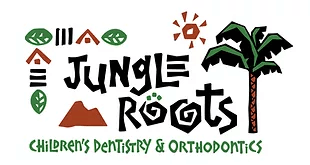As we begin a new year, it’s always fun to reflect on the highlights of years past. For us here at Jungle Roots, it’s interesting to think about how far the dental and orthodontic professions have come since the earliest days of tooth care. Join us as we take a walk-through time and look at some wild and wacky ways the world has thought about teeth throughout history.

Some of the original dentures of the past were made from hippopotamus teeth, although later varieties were constructed of very expensive ivory.
To treat a toothache, ancient Egyptians used to grind up dead mice with several other ingredients and apply the mousey mixture directly to the painful tooth.
Medieval Germans believed the only way to cure a toothache was by kissing a donkey.
In Nigeria, killing a rooster at the first sign of a baby tooth erupting was encouraged to prevent teething pain.
Cherokee children are said to have run around the house with the lost baby tooth in hand, then throw it up on the roof and say four times, “Beaver, put a new tooth on my jaw!” This was believed to call spiritually upon the beaver with their strong teeth to help the child’s permanent tooth to grow in sturdy and pain-free.
Amulets made from animal teeth were believed to aid in pain-free teething and help to grow strong teeth as well.
Yupik and Shuswap children mix their lost baby teeth with meat and feed it to dogs to make their permanent teeth come in strong.
Animals were included in certain prescriptions, too. One example is, “Permit the child to be licked by a dog” in order to alleviate teething pain.
Native American tribes have long passed on many of their own dental traditions, including:
Chippewa tribes paint the lost baby tooth black with charcoal and throw it to the west, simultaneously asking the baby’s grandmother if she will help the permanent tooth to grow in strong.
Navajo children bury their tooth on the east side of either sagebrush, rabbitbrush, or sometimes a pinyon tree, on the southeast side of the property away from their home.
Teton children bury their teeth in the dirt in the entryway of their house. Anyone who walks over it is said to be helping to grow a new tooth.
The Dene Yellowknives children give their lost teeth to their mothers or grandmothers, who put them into trees around which the family dances to encourage permanent teeth to grow in as straight as a tree.
In Chile and Costa Rica, the first lost baby tooth is often plated in gold or other precious metal and then used as a charm or as an earring.
The remains of a young Mayan woman from around 630 AD. revealed 3 teeth had been replaced with seashell pieces. It was found through further exploration that the Mayans could create carved inlays containing turquoise, jadeite, quartz, serpentine, and others for prepared cavities in the mouth.
While we enjoy the benefits of modern-day dental hygiene, we can’t forget our ancestors’ struggle to clean their teeth and avoid toothaches -- generally by any means they could find. Some of these were quite strange by today’s standards.
Long before the toothbrushes of today, the very first, original ones were made of bone handles and hog bristles. These became popular in China around 1,400 years ago, when ancient people used makeshift toothpicks to clean their teeth. They were often made from bird feathers, porcupine quills, and animal bones. Also popular in several cultures were “chew sticks”, sometimes called ‘miswak’ which were made to clean teeth with the frayed end of a twig.
Prehistoric skulls found between 9,000 and 14,000 years ago reveal the possibility that ancient dental work was attempted and may have even included drilling with rudimentary drills and fillings that were made of beeswax or bitumen.
The earliest “toothpastes” were made of eggshells, crushed bones, oyster shells, and the powdered ashes of burned ox hooves.
As it became more popular to use human teeth in dentures, poor people increasingly sold their teeth to those who needed them, graveyards were raided for the teeth of the deceased, and fallen soldiers’ teeth were removed from the battlefield after battles.
Before the 1800s, you could visit your barber for a haircut, dental care, and even surgery. That’s because all 3 professions were grouped into one in the days of old, mostly because the barber already had sharp tools needed for tooth extraction and surgery. The physicians of the day also considered surgery beneath them, so they didn’t mind barbers taking up the task.
Mouthwashes were used in the ancient world from Egypt to Greece to China and Rome. Here’s a little bit about them:
The ancient Romans used urine as mouthwash (yes, really!) which was believed to disinfect the mouth and whiten the teeth.
Ancient Greeks made mouthwash with donkey milk, which was believed to promote strong teeth.
Various types of ancient combos have also been used as mouthwash including tortoise blood, cold water, mint leaves, wine, and vinegar.
Last year we talked about some of the prominent ways other cultures celebrate the loss of baby teeth. Depending upon the tradition, recently lost baby teeth might be buried, thrown toward the sun or down at the ground, wrapped in bread and fed to animals, and more. In addition to this, there exists plenty of folklore related to cavities and toothaches, a bunch of it still shared widely in some parts of the world today. These are:
Some Europeans, primarily Germans, believed in ancient times (and some even believe today) that slapping a baby’s face at the first sign of a tooth appearing will help the tooth to come in without pain. (Of course, here at Jungle Roots, we disagree with this completely, just to clarify!)
Tiny worms were believed to cause tooth pain during medieval times. They were thought to bore into the teeth and wiggle inside the tooth which caused toothaches. When the pain stopped at times, it was believed the worms were resting.
During the English Tudor era, sugar was expensive and available only to the rich who added it to almost everything, simply because they could. Rotting, black teeth, as a result, became associated with the rich when Queen Elizabeth's black teeth became popular. The look eventually became such a status symbol during these times that the poor used to blacken their teeth in order to appear rich.
Around the 11th century, a book about women's cosmetics revealed that it had become a preference to have white teeth instead of black. This book directed women to, “Take burnt white marble and burnt date pits and white natron, a red tile, salt, and pumice. From all of these make a powder in which damp wool has been wrapped in a fine linen cloth. Rub the teeth inside and out. The woman should wash her mouth after dinner with very good wine. Then she ought to dry very well and wipe with a new white cloth. Finally, let her chew each day fennel or lovage or parsley, which is better to chew because it gives off a good smell and cleans good gums and makes the teeth very white."
Welsh folklore from the 13th century included many herbal and plant remedies for tooth pain, such as ivy bark, honeysuckle leaves, thorn apple, holly leaves, and several others. Some of these were shaped together into balls and held between the aching tooth and cheek. Once in place, patients were instructed to go for a casual mile-long walk, spitting away the saliva as it collected. After this was done three times with new balls, the remedy directs the patient to lie in bed and warm themselves and the pain will stop.
For a painless tooth extraction, it was recommended to take some newts and a certain type of “nasty” beetles and combine them in an iron pot. Then, make a powder of them and apply with the first finger on the right hand onto the painful tooth, repeating often. Do not spit it out, and the tooth will fall out painlessly.
Applied with a linen cloth, a mixture of red rose water, beeswax, and fresh butter on embers should be brought to as high a heat as possible, then placed upon the patient’s painful jaw.
Another remedy says to engrave certain words onto an iron nail, then insert the nail under the painful tooth. After this, drive the nail into an oak tree and carve the name of the person who is in pain onto the tree, saying a prayer. After this, as long as the nail remains in the tree, the toothache won’t return.
At any time when you bathe, rub the insides of your ears with your fingers to alleviate tooth pain.
As we look to the future, it’s important to reflect on the past and marvel at how we got to this place in time. This new year, we at Jungle Roots are grateful for all the original dentists, orthodontists, and ancient visionaries who set the innovations of today in motion--as well as our patients and their families who make this work continue to be worthwhile. We look forward to seeing you soon and wish you and yours a very Happy New Year!

At Jungle Roots Children’s Dentistry & Orthodontics, we strive to provide the highest comprehensive pediatric and orthodontic dental care in a unique, fun-filled environment staffed by a team of caring, energetic professionals. We believe the establishment of a “dental home” at an early age is the key to a lifetime of positive visits to the dentist.
#ahwatukee#Arizona#chandler#dental#dentalcare#dentist#dentistry#health#JungleRoots#mom#OralHealth#phoenix#teeth#wellness
References and additional interesting information:
